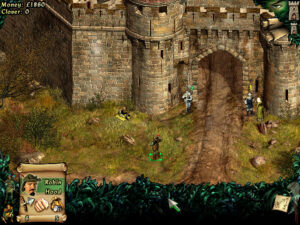Robin Hood: Combat Mode
When characters in this game trade blows with sword or staff, they become locked in a combat mode that only ends if one of them is downed (either dead or unconscious) or one of them somehow manages to put enough distance between self and assailant to break it. In this mode, characters cannot take any of their special per-character actions, like throwing coin purses or eating food to heal themselves. (This is why Robin can generally needs to take enemies by surprise to pull off a sucker punch: once they’ve drawn a sword, they can force him into combat mode instead.) Once they’re in combat mode, they don’t need to be told what to do; they’ll just keep fighting. If you want them to fight effectively, however, you’ll want to take direct control.
This is done by means of mouse gestures. Select a character in combat mode and left-drag on the playfield, and the cursor will leave an orange trail behind it, so you can draw a simple shape that determines what you do. A straight line towards an enemy means a thrust, a circular arc means a swing that can hit multiple people, stuff like that. A figure 8 does a slow but powerful finishing blow. It’s all clearly meant to convey a sense of the cut and thrust of swashbuckling, but, like most mouse gesture systems, I mainly find it a little awkward. It’s made especially awkward by context: when the selected character isn’t in combat mode, left-dragging on the playfield is interpreted as a “select multiple’ action, as is normal in RTS interfaces. And in large melees where multiple foes are attacking a character at once (which is to say, the situations where manual control is most crucial), it happens fairly frequently that I try to do a swing just after the enemy I was targeting falls, resulting in deselecting the character I was controlling. There should be a name for this general sort of erroneous behavior resulting from transient changes in state changing the meaning of an action.
Apart from that, I find it interesting that this whole system tends to result in the action centering on one fight at a time. Fights that aren’t currently the focus of your attention tend to go into a holding pattern, both sides fending off most of each other’s automatic attacks, unless one side or the other is greatly outmatched in skill or numbers. Selecting a character to control is, in effect, like directing the camera in the swashbuckling films the game takes inspiration from, telling the game that this is the important one for the moment.
 Comments(0)
Comments(0)